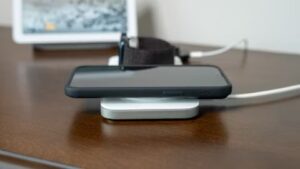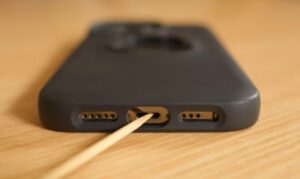- To fix an iPhone that won’t turn on after iOS 18 update, first try charging it with different cables and cleaning the charging port.
- You can also try performing a force restart, checking for hardware issues, or performing a recovery or DFU restore.
- If all else fails, send it to Apple for repairs.

You turn on your iPhone by pressing the Side button — simple. If that button won’t work, your device isn’t necessarily broken — there are ways to bring it back to life.
This problem can be caused by software or hardware issues. Your iPhone may not be powering on after iOS 18 update because of an iOS system crash. You may also experience this problem if your iPhone suffers a hardware damage. Either way, there are things you can try to get it to power back on.
Why Won’t My iPhone Turn On after iOS 18 update?
There are a few things that can lead to your iPhone not turning on after iOS 18 update, and we’ll try to address them all in this guide.
- iOS system crash: A bug in the iOS system may lead to your iPhone not turning on after updating to iOS 18.
-
Dead battery: Sometimes, the simplest explanation is the reason. Your iPhone battery may just be dead. Since the device consumes a lot of battery during the update process, your iPhone may not be turning on due to lack of enough power. If it’s been dead for a while, the display won’t even be able to turn on long enough to tell you that. This can be caused by bad charging cables, debris in the port, or a battery failure.
-
Hardware damage: Finally, maybe it’s just that the screen literally won’t turn on, but the iPhone is actually powered on. That can be caused by damage to the screen itself.
7 Methods To Fix iPhone not turning on after iOS 18 update
I also experienced this problem. My iPhone 15 Pro Max refused to turn on after updating to iOS 18. After reaching out to Apple support, here’s what they recommended I do.
Please try the methods below to see if they help!
Method 1: Charge your iPhone
Usually, a "low battery" indicator appears on the screen when you try to turn on an iPhone and it doesn’t have enough battery power. However, when the battery is completely dead, your iPhone won’t respond at all when you press the Power button, and you’ll just see a black screen.
To fix this problem, just plug your iPhone into a wall charger and let it charge. for at least 15 minutes.If the battery is completely dead, you can’t just plug it in and expect it to respond immediately. When there’s enough charge to do so, an iPhone will automatically turn on while charging.
If your iPhone still doesn’t turn on, you can try the same thing with a different charging cable and adapter. Alternatively, you could try wireless charging if your iPhone supports this feature. The point here is to allow the iPhone enough time to charge up to power on. It may seem futile, but you should rule out a dead battery before trying other troubleshooting methods.
Method 2: Clean Out the Charging Port of your iPhone

Before you give up on charging your iPhone, i recommend that you inspect the charging port on your device to make sure that its clear and clean. Sometimes, debris—such as lint and dust—can make their way inside the port and interfere with the charging connection. The repeated plugging in compacts the debris until you need to clean it out.
Take a flashlight and look inside the port. If you see anything foreign, your charging port need some cleaning. Do not clean using anything metalic—such as a paperclip or SIM tool—as it may damage the charging port. Instead, reach for something softer, like a wooden toothpick. Poke around carefully to pry out anything that’s trapped inside the port.
Now, try charging your iPhone again. Does it turn on now? If it doesn’t, move onto the next solution.
See also: How to fix iPhone not charging after iOS 18 update issue
Method 3: Force Restart iPhone
If you’re iPhone still won’t turn on even if you charge it, try force restarting your device. This doesn’t erase any data from your iPhone. Here’s how you can Force your iPhone to restart:
- Press and quickly release the volume up button.
- Press and quickly release the volume down button.
- Press and hold the side button until you see the Apple logo (this takes around 10 seconds).
Does your iPhone turn on? If not, move on to the next method.
Method 4: Enter Recovery Mode to Restore iPhone
When your iPhone doesn’t turn on after iOS 18 update and shows the following symptoms during startup, it’s very likely that your iPhone is dead due to a software glitch:
- The iPhone frozen in boot loop not turning on.
- The Apple logo shows up on your screen not moving.
- iPhone shows a red screen.
- iPhone shows a blue screen.
- iPhone stuck in black screen with spinning wheel.
To fix these issues, simply put your iPhone into recovery mode and restore it. Follow these steps:
- Connect your iPhone to a Mac or PC.
- Select your iPhone on your computer.
- While your iPhone is connected, follow these steps:
- Press and quickly release the volume up button.
- Press and quickly release the volume down button.
- Press and hold the side button.
- Keep holding the Side button until you see the recovery mode screen.
- When asked to update or restore, choose Update.
- Your computer will download the software for your device. If it takes more than 15 minutes, your device will exit recovery mode. Repeat steps 2-3.
Method 5: Enter DFU Mode to Restore iPhone
When all else fails, a DFU restore is the last resort. When an iPhone refuses to boot up after iOS 18 update, you need to restore it using DFU mode. We’ll need to perform some key presses to enter DFU Mode on your iPhone. DFU mode can be tricky getting into. The timing with all the buttons has to be PERFECT. Here’s how:
- Connect your iPhone to a computer using a USB cable.
- While your iPhone is connected, follow these steps:
- Press and quickly release the Volume Up button
- Press and quickly release the Volume Down button
- Hold down the Side button until the screen goes black, then hold down both the Side button and Volume Down button.
- After 5 seconds, release the Side button while continuing to hold down the Volume Down button.
- Release the volume down button when your iPhone shows up in iTunes or Finder.
- If the Apple logo appears, the Side button was held down for too long.
- Nothing will be displayed on the screen when the iPhone is in DFU mode. If open, iTunes or Finder will alert you that a device was detected in recovery mode.
- If your device shows a screen telling you to connect the device to a computer, retry these steps.
- Restore your iPhone.
Method 6: Troubleshoot a hardware problem
If the screen isn’t working on your iPhone, you could be under the false impression that the device isn’t turned on. This can be caused by dropping the phone, even if you don’t see obvious cracks—though that’s usually a good indicator.
So how can you tell if the phone is on and the screen isn’t working? Try this:
- Hold down the Power button for 20-30 seconds—or plug your iPhone to a wall outlet for 10-15 minutes—to ensure it’s powered on.
- Grab another phone and call the iPhone that won’t turn on—or ask a friend to call you.
- If your iPhone rings or vibrates, you know the screen isn’t working. Unfortunately, this won’t be very helpful if you’ve enabled focus mode on your iPhone.
- Contact Apple to have your phone serviced or replaced.
Method 7: Take Your iPhone to Apple
If everything fails, the iPhone not turning on after iOS 18 update is likely due to physical damage or other hardware issues. In that case, you must contact Apple Support or take your iPhone to a nearby Apple Store or an Apple Authorized Service Provider.
Although an iPhone that won’t turn on can be an immediate cause for concern, it’s worth trying a few software fixes before seeking professional help, especially if you haven’t physically damaged your iPhone. However, in case of hardware damage, the only option is to contact Apple or an authorized service provider for help.

